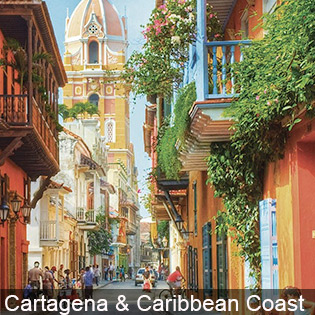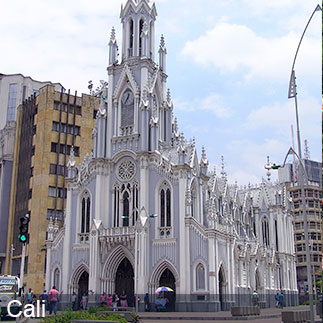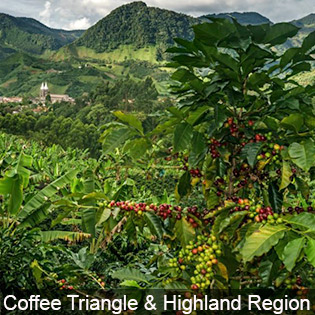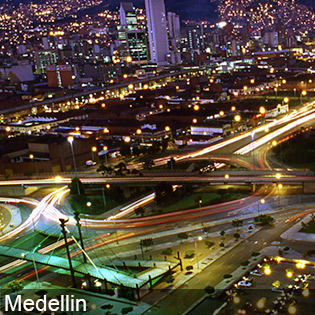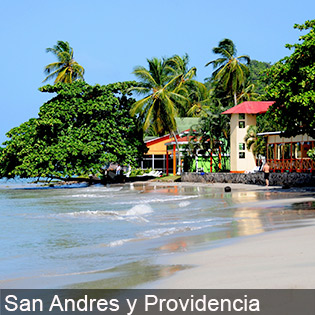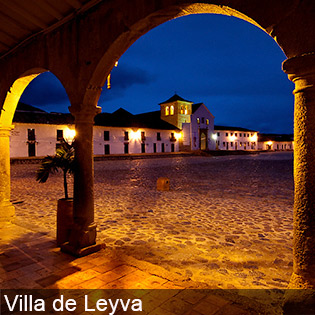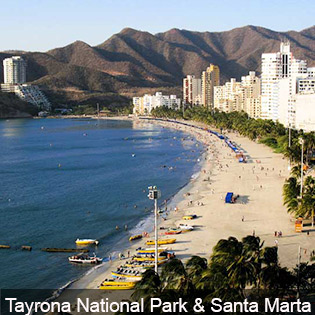COLOMBIA: Region by Region
Welcome to our Region by Region section. This section is intended to provide more details of each county’s regions, highlighting the region’s attributes and points of interest, including what to see, best time to see it; suggested length of stay, and more. Moreover, this section provides the independent traveler the opportunity to consider what cities and regions interest them most. While our Pre-designed tour menu provides a wide range of suggested popular tour programs, the Region by Region sections allows you to custom-design the tour of your choice.
Bogota

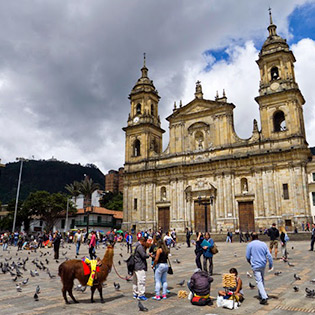
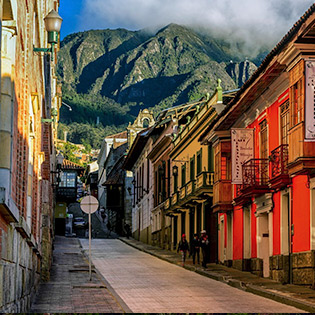
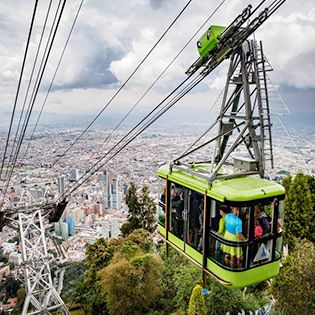
Overview
Bogotá's sheer size and (outdated) violent reputation can be intimidating. But for the savvy traveler, Bogota is engaging, boasting incredible riches befitting the capital of Colombia, one of the largest cities in Latin America. Historic riches and well preserved historic quarter bodes well for the city’s claim of being the original capital of Spanish colonial South America, as the capital of the vast New Kingdom of Granada, placed strategically close to mythical El Dorado. Pressed against the dramatic Eastern Andes peaks, Colombia’s sprawling, high-altitude capital offers an interesting mix of old and new. Visit the historic, colonial downtown section of La Candelaria, its cobblestoned center featuring colonial-era landmarks like the neoclassical performance hall Teatro Colón and the 17th-century Iglesia de San Francisco. It's also home to popular museums including the Museo Botero, showcasing Fernando Botero's art, and the famous Gold Museum (Museo del Oro), displaying 55,000 pre-Columbian gold pieces. The city’s eclectic blend offers culinary riches—its several dining districts play host to world-class restaurants representing all the world's cuisines; traditional and modern, frequented by the local jet set crowd. Rich nightlife that lasts well into the night at sweaty salsa clubs. Bogota has something for everyone.
Recommended Stay
Three to Five nights
When to go
The best time of year to travel to Bogotá is probably during the months of December to April, and June to September. These are the months when the weather is driest and the average temperature stays around 60 °F.
Highlights
- Monserrate: a mountain of almost 3152 meter and a postcard symbol of Bogota. Take the cable car or train or walk.
- Gold Museum (Museo del Oro): Opened in 1939 by the Bank of the Republic to help preserve Colombian artifacts, the Museo del Oro houses the largest collection of Pre-Hispanic gold work in the world, a collection of 55,000 pieces of ancient works by indigenous cultures of Colombia.
- Botero Museum: Visit the Botero Museum to view interesting art collection including the works of renowned Colombian artist Fernando Botero. Spot paintings by revered international artists such as Salvador Dalí and Pablo Picasso.
- Salt Cathedral (Catedral de Sal): Located in Zipaquirá, about 50 kilometers north of Bogota, is an underground church built in a tunnel deep inside a salt mine.
- Paloquemao Market: This market is a sight to behold. Located on a large block next to a modern shopping center in the busy industrial center of the city, you’ll find thousands of shoppers, sellers and fascinating characters packed together in a massive rabbit warren where deals are being made on an incredible variety of items.
Caño Cristales
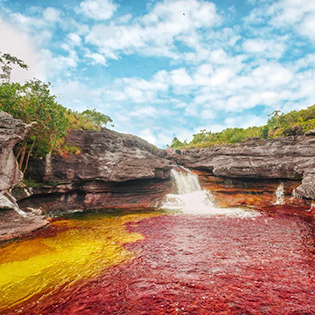
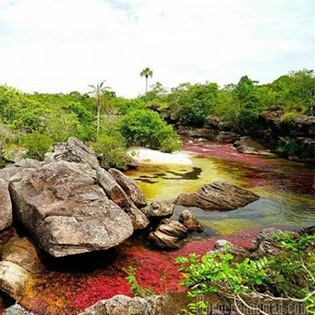
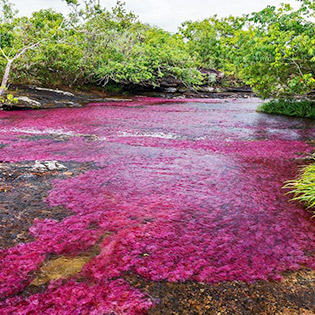
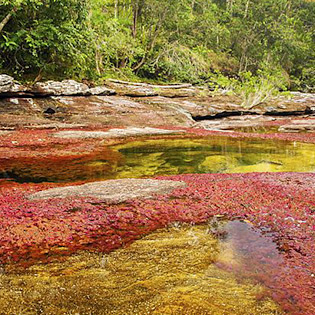
Overview
Caño Cristales is located in a remote, isolated mountain range, Serrania de la Macarena, in the department of Meta. Caño Cristales is also commonly known, among many other monikers, as the “River of Five Colors”. It gains its names and reputation for being one of the most beautiful rivers in the world from the brilliant, changing colors of the aquatic plants that line the bottom of the river. The river is in a remote area and not easily accessible by road with only small towns nearby. Adventurous tourists can now fly into the nearby town of La Macarena. From there it is a short trip into “Serrania de la Macarena,” the national park in which Caño Cristales is located. For most of the year, Caño Cristales is indistinguishable from any other river: a bed of rocks covered in dull green mosses are visible below a cool, clear current. However, for a brief period of time every year, the river blossoms in a vibrant explosion of colors. During the short span between the wet and dry seasons, when the water level is just right, a unique species of plant that lines the river floor called Macarenia clavigera turns a brilliant red. It is offset by splotches of yellow and green sand, blue water, and a thousand shades in between. This only happens for a brief period in between seasons. During the wet season, the water flows too fast and deep, obscuring the bottom of the river and denying the Macarenia clavigera the sun that it needs to turn red. During the dry season there is not enough water to support the dazzling array of life in the river. But for a few weeks from July through November, the river transforms into a veritable living rainbow.
Recommended Stay
Two to Four nights
When to go
Despite being in a more mountainous terrain, the local climate is fairly temperate all year round, and is separated into two distinct seasons: the wet season and the dry season. Best time to view the colorful spectacle is from July to November… maybe December also.
Highlights
Cartagena & Caribbean Coast
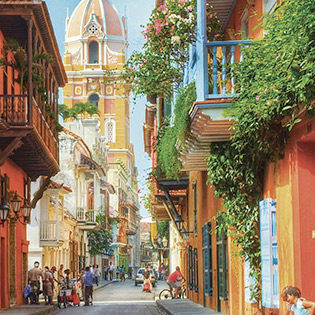

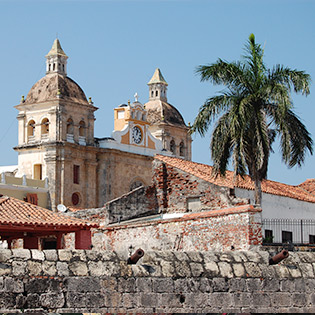
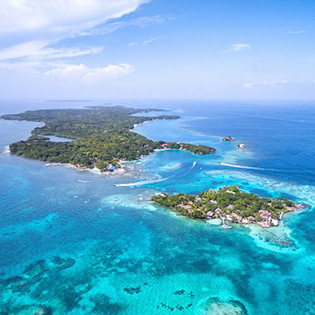
Overview
Sun-soaked and stewed in culture, Colombia's dramatic Caribbean coastline is its dazzling crown, capping the country with myriad ecosystems, from the dense jungles of the Darién Gap on the border with Panama, to the hauntingly atmospheric desert of La Guajira near Venezuela. The crown jewel along the coast is Cartagena, a colonial city with a beauty unrivaled anywhere in Colombia. A fairy-tale city of romance, legends and superbly preserved beauty lying within an impressive 8 miles of centuries-old colonial stone walls. Cartagena's Old Town is a Unesco World Heritage site – a maze of cobbled alleys, balconies covered in bougainvillea, and massive churches that cast their shadows across leafy plazas. We invited you to stroll through the Old Town day or night and enjoy the plazas and restaurants come alive at night, and its colonial architecture is unmatched anywhere on the Western Hemisphere. North of Cartagena, check out Santa Marta, the first Spanish settlement in Colombia. It's the gateway for trips into the Tayrona National Natural Park, and for multiday guided treks to the Lost City (Teyuna) archaeological site in the Sierra Nevada de Santa Marta Mountains. Mompox or Mompós, officially Santa Cruz de Mompox enjoys a growing number of visitors falling in love with.
Recommended Stay
Three to Seven nights
When to go
This is a year-round destination. The best time to visit is late December to late April. The hottest months are June, September, and then July. The warmest time of year is generally early June where highs are regularly around 91.4°F (33°C) with temperatures rarely dropping below 79.5°F (26.4°C) at night.
Highlights
- Cartagena Historic Center: Without doubt, Cartagena's old city is its principal attraction, particularly the inner walled town, consisting of the historical districts of El Centro and San Diego
- Popa Hill (La Popa Convent): There is limited access to this Convent. No large groups or large buses allowed. The best view of Cartagena is offered from the convent of La Candelaria, located on top of the La Popa hill. The convent, built in 1606 by the Augustinian Recollect fathers, contains treasures such as an altar adorned with gold leaf and oil paintings.
- Rum & Chocolate Tasting: The specialized Colombian rum and chocolate tasting tour is one of the most popular experience while in Cartagena. Each grade of rum and chocolate are carefully selected, and paired, to give the client a unique sensory experience. The spectrum of rum and chocolate spans the coastal and mountainous regions of Colombia, from the smallest artisanal houses to the largest producers.
- Salsa Tour & Lessons: This tour of Bogotá salsa clubs takes you to the best places to dance —locations only Bogotá locals know. Enjoy VIP access to three salsa clubs during the tour, sample local liquors like rum and aguardiente, and even try out your own moves after a fun salsa class. Your guide tells you all about the history and culture of salsa dancing in Colombia between bars.
- San Pedro Claver Church: Founded by Jesuits in the first half of the 17th century as Convento San Ignacio de Loyola, this convent's name was later changed in honor of Spanish-born monk Pedro Claver (1580–1654), who lived and died here. Called the 'Apostle of the Blacks' or the 'Slave of the Slaves,' the monk spent all his life ministering to the enslaved people brought from Africa. In 1888 he was the first person to be canonized in the New World.
- San Felipe Fortress: The greatest fortress ever built by the Spaniards in the Americas, dominating an entire section of Cartagena's cityscape
- Rosario Islands: The Islas del Rosario, also referred to as Corales Islas del Rosario, is an archipelago located off the coast of Colombia, approximately 60 miles from Cartagena. It is one of the 46 Natural National Parks of Colombia
- San Basilio de Palenque: The village of Palenque de San Basilio is located in the foothills of the Montes de María, southeast of Cartagena. The word "palenque" means "walled city" and the Palenque de San Basilio is only one of many walled communities that were founded by escaped slaves as a refuge in the seventeenth century.
- Santa Marta: This is an extension visit from Cartagena or a standalone destination. Established in 1525 by the Spanish as a base of conquest, Santa Marta sits at the foot of the world’s highest coastal mountain range, the towering Sierra Nevada de Santa Marta. It’s considered a top tourist destination and possesses a number of beautiful beaches, including El Rodadero, just 5-miles to the south, and Taganga, 3 miles to the north. It offers a broad range of activities and excursions -- including the area’s crown jewel, Tayrona National Park, a protected region of teeming biodiversity covering approximately 12 square miles of the Caribbean Sea and 45 square miles of accessible beaches, horseshoe bays and rain forest habitat. Naturally, it’s also one of the top destinations for domestic tourism within Colombia
Coffee Triangle & Highland Region
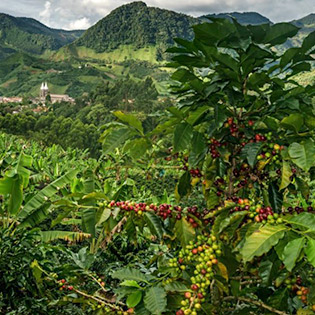
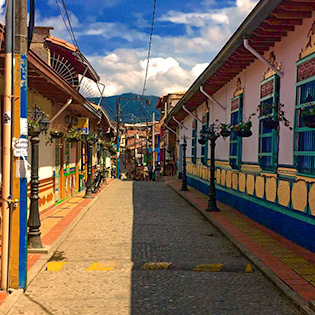
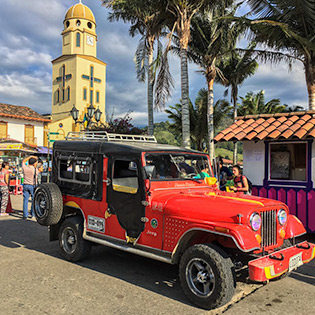

Overview
The Colombian coffee Region, also known as the Coffee Triangle is a part of the Colombian Paisa region in the rural area of Colombia. Colombia’s best geography for coffee production also happens to be ideal for tourism. Christened the Coffee Triangle, the central Andes departments of Caldas, Quindío, and Risaralda are dotted with haciendas turned chic guesthouses. Rolling green landscape with soaring wax palms (the world’s tallest) are ideal for horse treks and hummingbird sightings. And then, of course, there’s an ample supply of the best-quality coffee in the world. The region is famous for producing the majority of Colombian coffee, considered by some as the best in the world, and one of the country’s most popular tourist destinations. People from around the world flock to this beautiful part of Colombia to enjoy stunning landscapes, beautiful little towns, and, of course, world-class coffee. There are numerous wonderful places to visit and a multitude of sights to see in the Coffee Region, but there are some particular experiences that stand out and are unmissable. Arguably the most popular destination the Coffee Triangle is the lovely little town of Salento. With its colorful traditional architecture, excellent variety of restaurants, and coffee tours, Salento is already established as a must-visit spot on the Colombian traveler trail. Equally popular is the nearby Valle de Cocora – a stunning trek with cartoon-like trees dotting the landscape.
Recommended Stay
Two to Three nights
When to go
Colombia is located near to the equator meaning it doesn’t have distinctive seasons. The climate in each area remains fairly constant year-round. Although there are no seasons, there are drier periods which Colombians refer to as “Summer” and the wetter seasons as “Winter”. Generally speaking the best (driest) weather is from December to March and June to August with the highest rainfall occurring in May and October.
Highlights
- Salento: Set amid gorgeous green mountains 24km northeast of Armenia, Salento is a sleepy little town in Quindio department, in the Coffee Region. It’s a small town survives on coffee production, trout farming and, increasingly, tourists, who are drawn by its quaint streets, typical paisa architecture and its proximity to the spectacular Valle de Cocora. Founded in 1850 its one of the oldest towns in Quindío.
- Filandia: Although Salento is the golden child of Colombia’s coffee region, there’s a little-underrated town about 45 minutes away that deserves more attention. This quaint pueblo is called Filandia, and is a must for anyone looking for an authentic experience in the Zona Cafetera region.
- The Cocora Valley: In a country full of beautiful landscapes, Cocora is one of the most striking. It stretches east of Salento into the lower reaches of PNN Los Nevados, with a broad green valley framed by sharp peaks. Everywhere you'll see palma de cera (wax palm), the largest palm in the world (up to 60m tall). It's Colombia's national tree.
- Coffee Farm Tours: This tour gives you a great insight into all things coffee both at a global and Colombian level - and having a professional expresso machine with coffee roasted on the spot and unlimited access was brilliant.
- Quindio's Botanical & Butterfly Garden: One of Colombia's truly enjoyable nature outings is the Jardín Botánico del Quindío, an enormous complex of botanical gardens outside Armenia. The highlight here is the mariposario, a butterfly-shaped butterfly house, home to about 1,500 butterflies, representing 50 different species. The expansive botanical gardens boasts a diverse species of orchid that grow in Colombia.
Medellin
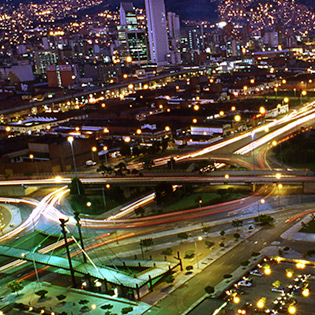
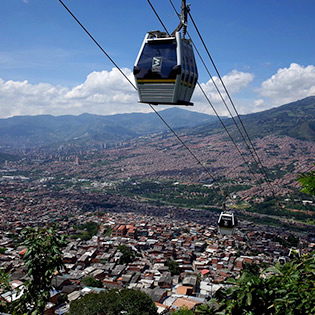
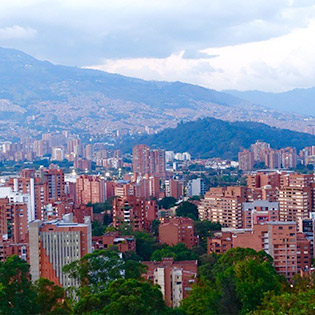
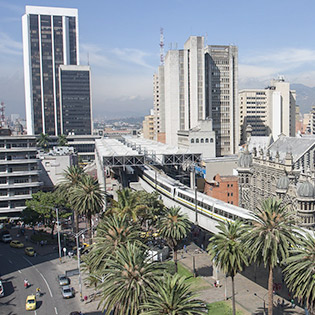
Overview
Medellín is the capital of Colombia’s mountainous Antioquia province. The "City of Eternal Spring," as Colombians affectionately call it because of its temperate climate, is fast becoming a tourist hot spot for fine dining, trendy bars and, of course, world-class coffee. The capital of Antioquia offers visitors the chance to experience the bustling, chaotic Colombian culture amid a backdrop of soaring mountains and leafy coffee plantations. It's a bustling place of industry and commerce, especially textile manufacturing and exported cut flowers. With a climate perfectly suited for year-round blooms, Colombia is one of the world’s biggest exporters of flowers. Each August, the South American country celebrates its floral heritage at the Festival of the Flowers in Medellin. The 10-day festival is the ideal time to visit the Antioquian capital: Colombians love a party, and the event is your chance to take part – among the blooms of thousands of colorful flowers. On weekends Medellin lets its hair down, its many discos attracting the beautiful people. The city sprawls north and south along the valley floor; slums hug the upper reaches of the hills. True to its paisa (people of Antioquia) roots, Medellín affects an indifference to the rest of Colombia, putting on metropolitan airs and looking overseas for inspiration for its next great public-works projects.
Recommended Stay
Two to Three nights
When to go
Medellin is a year-round destination and temperature stay pretty much the same. The hottest months are June, July, and August. The warmest time of year is generally late July where highs are regularly around 84.3°F (29.1°C) with temperatures rarely dropping below 63.5°F (17.5°C) at night.
Highlights
- Flowers Fair: Famous for its flowers, Medellin holds an annual Flower Festival in August. The festival typically lasts for about a week (dates move around, so check ahead of time to see when the festival falls) and includes all sorts of extravaganza, from fireworks displays, classic car parades, flower exhibits and of course the main course – el Desfile de los Silleteros – or a Flower Parade.
- Santa Elena: This tour will take you by the Antiochian countryside where traditional families plant flowers while every year waiting to display them to the world during the annual flower fair held in August.
- Medellin's Social Transformation: Medellin is experiencing an extraordinary transformation. Although it was known during the 1980s and most of the 1990s as the most violent city of the world, the city is putting those years behind by working toward building a more inclusive, vibrant, and resilient city.
- Penol & Guatape, Heritage Towns: We visit outside of Medellin to the famous Guatape and El Penol. Enjoy touring the Guatape lagoons, the colorful town of Guatape, hike El Peñol, and more.
San Agustín & Popayán

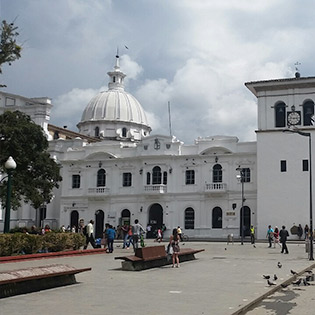

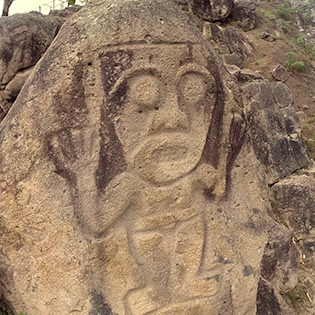
Overview
Five thousand years ago, two indigenous cultures lived in the adjacent river valleys of the Magdalena and the Cauca. Divided by uncrossable peaks, the rivers acted as their highways, and here, near San Agustín, within several days' march of each other, lie the headwaters of both rivers. It is here that those two civilizations met to trade, to worship, and to bury their dead. The volcanic rocks thrown great distances by the now-extinct nearby volcanoes proved irresistible to the local sculptors, who set about working them into grand monuments. The result is more than 500 statues (the largest is 7m high) scattered over a wide area in the lush green hills surrounding San Agustín. Many of them are anthropomorphic figures, some realistic, others resembling masked monsters. There are also sculptures depicting sacred animals such as the eagle, jaguar and frog. Archaeologists have also uncovered a great deal of pottery. Little else is known about the peoples of San Agustín. They didn't have a written language and had disappeared many centuries before the Europeans arrived. But their legacy is one of the most important archaeological sites on the continent – a mystical place in a spectacular landscape that is well worth making a detour for. Popayan is a small colonial city famous for its chalk-white facades (its nickname is La Ciudad Blanca, or 'the White City'). , Popayán is second only to Cartagena as Colombia's most impressive colonial settlement. Perched beneath towering mountains in the Valle de Pubenza, it was the capital of southern Colombia for centuries, before overtaken by Cali.
Recommended Stay
Two to Three nights each region
When to go
The best time to visit St. Augustine is between March and May. During this time, you'll find fewer people, comfortable temperatures and low hotel and airfare rates. Crowds are typically at their largest from June to August, while temperatures can drop into the 40s between December and February.
Highlights
- San Agustin Archeological Park: The largest group of religious monuments and megalithic sculptures in South America stands in a wild, spectacular landscape. Gods and mythical animals are skilfully represented in styles ranging from abstract to realist. These works of art display the creativity and imagination of a northern Andean culture that flourished from the 1st to the 8th century.
- Isnos: Visit of the archaeological sites of Alto de Piedras and Alto del Idolo and the waterfall of Mortino.
- Popayan´s Historic Center: The Parque Caldas in the center of Popayán is a lovely pedestrian square and the city’s main point of reference. It’s a fantastic place to have a coffee (there’s a Juan Valdez Café on the square) or just hang out, day or night. Your discovery of Popayán begins here.
- Guambiano Market in Silvia: In the small town of Silvia, Colombia a timeless scene plays itself out every Tuesday. People come in from the surrounding villages, sell their fruits, vegetables, meat, traditional medicine, and catch up on the latest news. The market is mainly staffed by the indigenous Guambiano Indians, who live in the nearby areas and have largely maintained their traditional way of life. Guambianos young and old come to town and it’s really something beautiful to see.
San Andres y Providencia


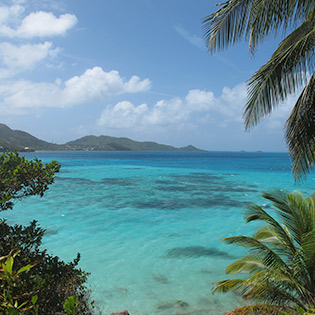
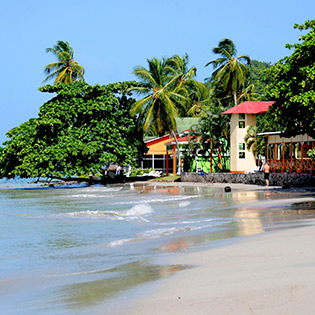
Overview
Archipelago of San Andrés, Providencia and Santa Catalina, or, in everyday language, San Andrés y Providencia, is one of the departments of Colombia. San Andres and Providencia form part of a small archipelago located deep in the Caribbean sea, just under 800km off Colombia’s northern coast (and approximately 200km from Nicaragua). The population of the islands is predominately mestizo and creole; a legacy of the archipelago’s history, which was variously controlled by the British, Dutch and Spanish. This ethnic diversity is reflected in the islands’ linguistic make-up: islanders are trilingual, speaking English, Spanish and a creole dialect unique to the area. The small Caribbean islands of San Andres and Providencia are laid back retreats, boasting white sand beaches, turquoise waters and dramatic corral formations. San Andres is the larger of the two islands, has a wider range of accommodation and receives a greater number of visitors. Providencia is more rustic, but also more picturesque and relaxing than its larger neighbor.
Recommended Stay
Two to Three nights
When to go
Colombia is located near to the equator meaning it doesn’t have distinctive seasons. Average temperatures in San Andres do not vary. Considering humidity, temperatures feel hot all year with a fair chance of precipitation about half of the year. The hottest months are August, June, and July being the warmest time of year is generally late July where highs are regularly around 87.6°F (30.9°C) with temperatures rarely dropping below 79.8°F (26.6°C) at night.
Highlights
- Seaflower Biosphere Reserve: The Seaflower Biosphere Reserve encompasses the entire land and marine territory of the Archipelago of San Andres, Old Providence and Santa Catalina, a protectorate of Colombia in the southwest Caribbean Sea. The archipelago supports diverse marine and bird life, and extensive coral reefs.
- Johnny Cay: Johnny Cay Regional Park is a small island located east of San Andres just a short 10-minute boat ride. The beach is white, palm trees abound and there are restaurants serving fish dishes. Visitors can also enjoy live performances by local bands that play reggae songs.
- Scuba Diving: The location of San Andres in the Caribbean Sea brings a lot of sea life, crystal clear warm water and coral reefs. The island is known for its several keys and coral reefs that are the homes of a great variety of underwater fauna and flora.
Villa de Leyva
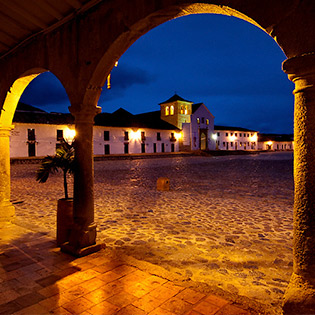
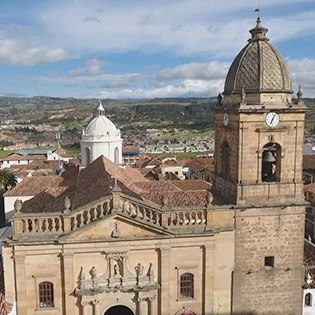

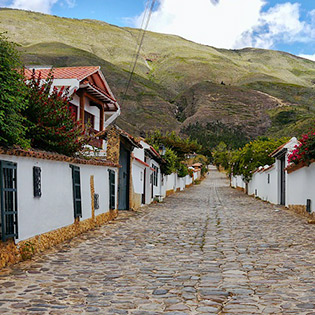
Overview
One of the most beautiful colonial villages in Colombia, Villa de Leyva is a city frozen in time. Situated northeast of Bogotá, the city is famous for its whitewashed colonial buildings, cobbled lanes and vast Plaza Mayor where in the early 17th-century Our Lady of the Rosary church and the House of the First Congress of the United Provinces are located where new laws were drafted after independence in 1812. Southwest of the plaza is the Antonio Nariño House Museum, where this war hero died. Declared a national monument in 1954, the photogenic village has been preserved in its entirety. The city's physical beauty and mild, dry climate have long attracted outsiders. The town was founded in 1572 by Hernán Suárez de Villalobos, and early on it was mainly a retreat for military officers, clergy and nobility. In recent years an influx of wealthy visitors and expats has slowly transformed this once-hidden gem. Boutique hotels, gourmet restaurants and tourist shops are replacing many of the old family hosterías and cafes. On weekends the narrow alleys can get downright crammed with day-trippers from Bogotá. But thankfully on weekdays it reverts to a peaceful, bucolic village, one of the loveliest places in Colombia. While here we typically also visits Zipaquira's Salt Cathedral and the charming town of Raquira.
Recommended Stay
One to Two nights
When to go
Temperatures in Villa de Leyva don’t vary much. Considering humidity, temperatures feel nice most of the year, excluding some cold weeks in the winter, with a fair chance of precipitation about half of the year. The hottest months are May, April, and then June. The warmest time of year is generally early to mid-May where highs are regularly around 69°F (20.6°C) with temperatures rarely dropping below 50.2°F (10.1°C) at night.
Highlights
- Villa de Leyva's Main Plaza and Town Center: The main square is unforgettable, considered the largest of its kind in the country. The cobbled expanse is interrupted by only one small fountain in the middle which was the water source for the village some four centuries ago. The little settlement boasts four churches all dating back to the sixteenth and early seventeenth centuries, the Iglesia Parroquial on the main square houses a most marvelous baroque ecclesiastical retable, additionally, it is located in a high altitude valley at 2,144 m altitude where fossils from the Mesozoic and the Cretaceous abound.
- Raquira: Twenty-five kilometers southwest of Villa de Leyva, Ráquira is the pottery capital of Colombia, where you'll find everything from ceramic bowls, jars and plates to toys and Christmas decorations. Brightly painted facades, a jumble of craft shops and stacks of freshly fired mud and clay pots make a welcoming sight along the main street of this one-horse town. There are many workshops in and around the village where you can watch pottery being made. The best time to visit is Sunday, when the local produce market is in full swing, but the souvenir shops are open every day.
- Candelaria's Desert: In this region, known as El Desierto de la Candelaria or Desert of the souls, the neogranadino “new granada style” Writer Pedro Solis Valenzuela wrote "The prodigious Desert", considered the first Hispanic American novels. Now the monastery serves as a retreat of the Augustinian Fathers but also provides restaurant services and lodging for visitors who are looking for a place to rest, meditate or simply relax. The arches resting on the half height columns and the brick floors of the monastery are an ideal place to reach such tranquility.
Tayrona National Park & Santa Marta

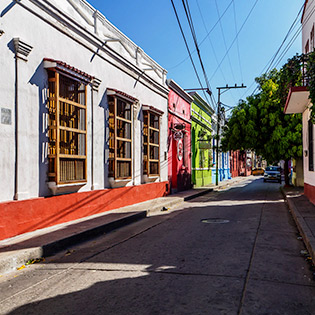
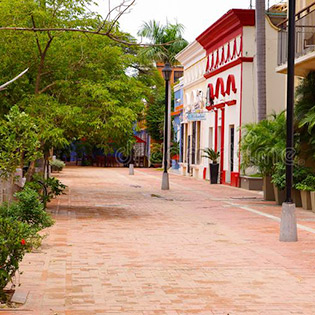

Overview
Santa Marta is a city on the Caribbean Sea in the northern Colombian department of Magdalena. A busy port, it was also the first Spanish settlement in the Americas. It's the gateway for visits to the Tayrona National Natural Park, and for multiday guided treks to the Lost City (Teyuna) archaeological site in the Sierra Nevada de Santa Marta Mountains. Parque Nacional Natural Tayrona is a magical slice of Colombia's Caribbean coast, with stunning stretches of golden sandy beach backed by coconut palms and thick rainforest. Behind it all rise the steep hillsides of the Sierra Nevada de Santa Marta, the world's highest coastal mountain range. The park stretches along the coast from the Bahía de Taganga near Santa Marta to the mouth of the Río Piedras, 35km to the east, and covers some 12,000 hectares of land and 3000 hectares of coral-rich sea. The park gets extremely crowded in the high season (Dec-Jan), and it's worth pointing out that vicious currents mean that most of the gorgeous beaches are not suitable for swimming, though you can take a dip and snorkel (with great care) at a select, safer few. Despite these issues, Tayrona is an immensely attractive place and one that's rewarding and exciting to explore. This is one of the most popular coastlines in the Americas, famed for its stunning, white-sand Caribbean beaches in the Tayrona National Park and the beautiful backdrop of the Sierra de Santa Marta Mountains to the south. This combination of beach and mountains makes for a fascinating region.
Recommended Stay
Three to five nightsWhen to go
This is a year-round destination. The hottest months are June, July, and then May. The warmest time of year is generally late July where highs are regularly around 93.8°F (34.3°C) with temperatures rarely dropping below 78.3°F (25.7°C) at night.Highlights
- Tayrona National Park: The Tayrona National Natural Park is one of the most popular natural parks in Colombia for its unspoiled natural beauty and biodiversity. The park contains some of the most beautiful beaches in Colombia, some bordered by coral reefs, providing good snorkeling and scuba-diving opportunities.
- Lost City: Discover Teyuna, the enigmatic Lost City of the indigenous Tayronas. The Lost City was built in 800 AD by the “Tayronas” who inhabited this area long before the arrival of the Spanish Conquistadors. Lost City has an architecture based on terraces made with an enigmatic disposition and a unique design never seen before in any ancient city in America.
- Santa Marta Historic Center: Santa Marta, founded by the Spanish in 1525, is the oldest city in Colombia and the second oldest in South America. This region is the site of one of the largest indigenous populations in Colombia, with around 30,000 people from the Arhuaco, Kankuamo, Kogi and Wiwa ethnic groups inhabiting the surrounding area. Its cultural and biological significance have been recognized by UNESCO since 1979. The main attraction of Santa Marta is the historic center. This area includes the impressive white fronted stone cathedral, which was the first built in the country and which has recently been restored, and Parque de Bolivar, featuring a statute of the liberation hero, and a gold museum located in the historic treasury building.
Cali

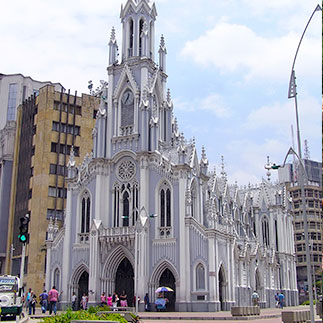
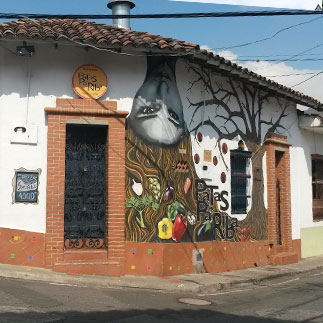

Overview
Cali is a Colombian city in the Valle del Cauca department, southwest of Bogotá. It's known for salsa dancing and there are many clubs in the suburb of Juanchito. In Cali's oldest quarter, the neoclassical San Pedro Cathedral houses paintings of the Quito School. Nearby is the 18th- and 19th-century San Francisco Religious Complex. La Merced Chapel is where the first mass was held after Cali was founded in 1536. It lies on both sides of the Cali River at an elevation of 3,327 feet (1,014 metres), in the subtropical intermontane Cauca Valley. The city was founded on July 25, 1536, by Sebastián de Benalcázar, a Spanish conqueror of Nicaragua, Ecuador, and southwestern Colombia. Cali did not develop economically until the 1950s, however, because of its landlocked position. It has since become Colombia's third largest city, after Bogota and Medellin. Cali is a hot, gritty city with a real zest for life that draws you in and stays with you long after you leave town. Beyond a handful of churches and museums, Cali is light on sights - but the city's main attraction is its beguiling, electrifying atmosphere. If you make the effort you will find great nightlife, good restaurants and plenty to do, especially in the evening, when a cool mountain breeze dissipates the heat of the day. Cali is rich in Afro-Colombian heritage; nowhere is the nation's racial diversity and harmony more apparent. From the impoverished barrios to the big, slick clubs, everyone is moving to one beat, and that beat is salsa. Music in the world's salsa capital is more than entertainment: it is a unifying factor that ties the city together.
Recommended Stay
Two to Three nights
When to go
The best time for the country as a whole is between December and March as it rains the least during these months, especially in the Andean regions. This is Colombia's peak tourist season and prices soar. Cali is a year-round destination and temperature stay pretty much the same. If you're looking for the very warmest time to visit Cali, the hottest months are September, August, and then July. See average monthly temperatures below. The warmest time of year is generally late July where highs are regularly around 89.5°F (31.9°C) with temperatures rarely dropping below 66°F (18.9°C) at night.
Highlights
- Cali, founded in 1536, can be explored on foot: walk under the shade of trees along the riverbank, admire the architecture of churches and other national monuments, and visit the city's many museums. In Cali, travelers can enjoy music festivals, learn about sugarcane farming, and take in the mountainous landscapes.
- Salsa... No trip to Cali would be complete without experiencing the city's number one claim to fame, the seductive sounds of salsa. There are numerous opportunities in Cali for tourists to try their hand at this energetic dance, as there are a number of dance academies and schools offering lessons tailor-made for beginners. The city has also earned a reputation as a major destination for shopping. Those who don't like to dance can watch a live performance, though the real action takes place within the city's sweltering clubs. Zaperoco Salsa Bar is hard to beat.
- Zoológico de Cali Widely considered to be the best zoo in Colombia, a trip to the Zoologico de Cali is a must for families and wildlife enthusiasts alike. Among the exotic animals on these expansive grounds are tigers, huge iguanas, monkeys, and pink Andean flamingos.
- Iglesia de San Antonio is set atop a hill to the west of the historical center lies Iglesia de San Antonio, a quaint 18th-century church that contains a number of unique wood-carved religious artifacts. Most come to enjoy the pleasant surrounding park, however, which affords excellent views of the city.
- Barrio San Antonio located down from the church lies Cali's historic center, the funky Barrio San Antonio. Within these charming colonial edifices are trendy cafés, happening bars, and upmarket restaurants, making it a perfect place to eat, drink, and be merry.



